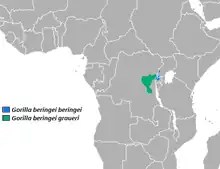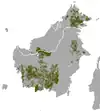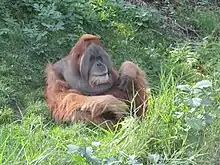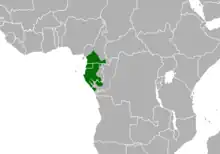This is a list of large extant primate species (excluding humans) that can be ordered by average weight or height range. There is no fixed definition of a large primate, it is typically assessed empirically.[1] Primates exhibit the highest levels of sexual dimorphism amongst mammals,[2] therefore the maximum body dimensions included in this list generally refer to male specimens.
Mandrills and baboons are monkeys; the rest of the species on this list are apes. Typically, Old World monkeys (paleotropical) are larger than New World monkeys (neotropical); the reasons for this are not entirely understood but several hypotheses have been generated.[3] As a rule, primate brains are "significantly larger" than those of other mammals with similar body sizes.[4] Until well into the 19th century, juvenile orangutans were taken from the wild and died within short order, eventually leading naturalists to mistakenly assume that the living specimens they briefly encountered and skeletons of adult orangutans were entirely different species.[5]
Largest non-human primates
| Image | Species | Binomial name | Weight range (kg) | Length (cm) | Height (cm) | Native area | Family | Range map |
|---|---|---|---|---|---|---|---|---|
.jpg.webp) |
Eastern gorilla | Gorilla beringei | 70–200 | 150–185[6] | 150–195[7] | East Africa | Hominidae |
|
 |
Western gorilla | Gorilla gorilla | 58–200[8] | 150–170 | 167–176[9]: pages181-182 | West Africa | Hominidae |
|
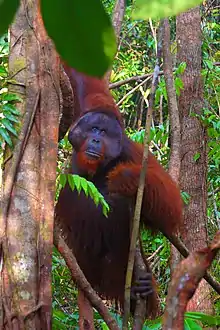 |
Bornean orangutan | Pongo pygmaeus | 30–100 | 100–170[10] | 100–140[11] | Borneo | Hominidae |
|
|
|
Sumatran orangutan | Pongo abelii | 45–90 | 120–180[12] | 90–170[13] | Sumatra | Hominidae |
|
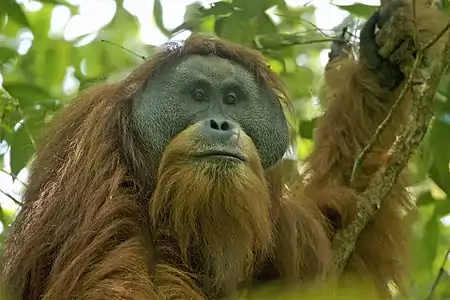 |
Tapanuli orangutan | Pongo tapanuliensis | 40–90 | 120–150[14] | 110–137[15] | Sumatra | Hominidae |
|
.jpg.webp) |
Chimpanzee | Pan troglodytes | 27–70 | 63–93 | 100–170[16] | Sub-Saharan Africa | Hominidae |
|
 |
Bonobo | Pan paniscus | 34–60 | 70–83[17] | 110–119[18] | Sub-Saharan Africa | Hominidae | |
 |
Mandrill | Mandrillus sphinx | 10–36 | 70–95[19] | 80[20] | West Africa | Cercopithecidae |
|
_male.jpg.webp) |
Chacma baboon | Papio ursinus | 12–32[21] | 50–115[22] | 50–75[23] | Southern Africa | Cercopithecidae |
|
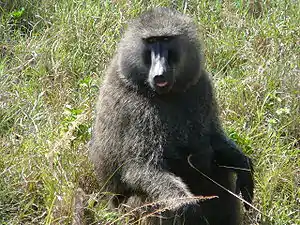 |
Olive baboon | Papio anubis | 10–24 | 50–114 | 55–70[21] | Sub-Saharan Africa | Cercopithecidae |
|
See also
References
- ↑ Size Influences on PrimateLocomotion and BodyShape, with SpecialEmphasis on theLocomotion of ‘SmallMammals’ In: Folia Primatologica Authors: H. Preuschoft, H. Witte, A. Christian, M. Fischer Date: 14 Feb 1996
- ↑ Dunham, A. E.; Maitner, B. S.; Razafindratsima, O. H.; Simmons, M. C.; Roy, C. L. (November 2013). "Body size and sexual size dimorphism in primates: influence of climate and net primary productivity". Journal of Evolutionary Biology. 26 (11): 2312–2320. doi:10.1111/jeb.12239. PMID 24016213.
- ↑ Cristoffer, Cris (1987). "Body Size Differences Between New World and Old World, Arboreal, Tropical Vertebrates: Cause and Consequences". Journal of Biogeography. 14 (2): 165–172. doi:10.2307/2845070. ISSN 0305-0270. JSTOR 2845070.
- ↑ Seyfarth, Robert M.; Cheney, Dorothy L. (2002-04-02). "What are big brains for?". Proceedings of the National Academy of Sciences. 99 (7): 4141–4142. Bibcode:2002PNAS...99.4141S. doi:10.1073/pnas.082105099. ISSN 0027-8424. PMC 123613. PMID 11929989.
- ↑ Herzfeld, Chris (2017). The great apes : a short history. Kevin Frey, Jane Goodall. New Haven. pp. 32–34. ISBN 978-0-300-22137-4. OCLC 982651819.
{{cite book}}: CS1 maint: location missing publisher (link) - ↑ Lindsley, Tracy; Sorin, Anna Bess. "Gorilla beringei (eastern gorilla)". Animal Diversity Web. Retrieved 2023-01-22.
- ↑ Csomos, Rebecca Ann. "Gorilla gorilla (western gorilla)". Animal Diversity Web. Retrieved 2023-01-22.
- ↑ Estrada, Alejandro; Garber, Paul A.; Rylands, Anthony B.; Roos, Christian; Fernandez-Duque, Eduardo; Di Fiore, Anthony; Nekaris, K. Anne-Isola; Nijman, Vincent; Heymann, Eckhard W.; Lambert, Joanna E.; Rovero, Francesco; Barelli, Claudia; Setchell, Joanna M.; Gillespie, Thomas R.; Mittermeier, Russell A. (2017-01-06). "Impending extinction crisis of the world's primates: Why primates matter". Science Advances. 3 (1): e1600946. Bibcode:2017SciA....3E0946E. doi:10.1126/sciadv.1600946. ISSN 2375-2548. PMC 5242557. PMID 28116351.
- ↑ Wilson, Don E.; Reeder, DeeAnn M. (2005). Mammal species of the world : a taxonomic and geographic reference. Baltimore: Johns Hopkins University Press. ISBN 0-8018-8221-4. OCLC 57557352.
- ↑ Ciszek, D.; Schommer, M.K. (2009-06-28). "ADW: Pongo pygmaeus: Information". Animal Diversity Web. Retrieved 2009-07-03.
- ↑ "bornean orangutan height - Google Search". www.google.com. Retrieved 2023-01-22.
- ↑ "Sumatran Orangutan | Species | WWF". World Wildlife Fund. Retrieved 2023-01-22.
- ↑ "Orangutan Pongo". Primate Info Net.
- ↑ "Tapanuli Orangutan, Pongo tapanuliensis | New England Primate Conservancy". neprimateconservancy.org. 2021-10-30. Retrieved 2023-01-22.
- ↑ "Tapanuli Orangutan". New England Primate Conservancy. Retrieved 2020-11-06.
- ↑ Shefferly, Nancy. "Pan troglodytes (chimpanzee)". Animal Diversity Web. Retrieved 2023-01-22.
- ↑ Burnie D, Wilson DE, eds. (2005). Animal: The Definitive Visual Guide to the World's Wildlife. DK Adult. ISBN 0-7894-7764-5.
- ↑ Coolidge, Shea (1982). "External body dimensions of Pan paniscus and Pan troglodytes chimpanzees". Primates. 23 (2): 245–251. doi:10.1007/BF02381164. S2CID 27818900.
- ↑ Dirks, W.; Lemmers, S. A. M.; Ngoubangoye, B.; Herbert, A.; Setchell, J. M. (2020). "Odontochronologies in male and female mandrills (Mandrillus sphinx) and the development of dental sexual dimorphism". American Journal of Physical Anthropology. 172 (4): 528–544. doi:10.1002/ajpa.24094. PMID 32510604. S2CID 219539657.
- ↑ Ingmarsson, Lisa. "Mandrillus sphinx (mandrill)". Animal Diversity Web. Retrieved 2023-01-22.
- 1 2 Burnie, D.; Wilson, D. E. (2005). Animal: The Definitive Visual Guide to the World's Wildlife. DK Adult. ISBN 978-0-7894-7764-4.
- ↑ Nowak, R.M. (1991). Walker's Mammals of the World. Baltimore and London: The Johns Hopkins University Press. ISBN 9780801857898.
- ↑ "Chacma baboon - Botswana Travel Guide". www.botswana-travel-guide.com. Retrieved 2023-01-22.
Further reading
- Campbell, Christina J.; Fuentes, Agustin; MacKinnon, Katherine (2011). Primates in perspective (2nd ed.). New York: Oxford University Press. ISBN 978-0-19-539043-8. OCLC 598304952.
- Wilson, Don E.; Mittermeier, Russell A.; Cavallini, Paolo, eds. (2009). Handbook of the mammals of the world. Vol. 3: Primates. Barcelona. ISBN 978-84-96553-49-1. OCLC 304148757.
{{cite book}}: CS1 maint: location missing publisher (link) - Tillquist, Richard C.; Shoemaker, Lauren G.; Knight, Kevin Bracy; Clauset, Aaron (2016-12-09). "The Evolution of Primate Body Size: Left-skewness, Maximum Size, and Cope's Rule". doi:10.1101/092866. S2CID 88769334.
{{cite journal}}: Cite journal requires|journal=(help) - Body Mass in Lowland Gorillas: A Quantitative Analysis (2019)
